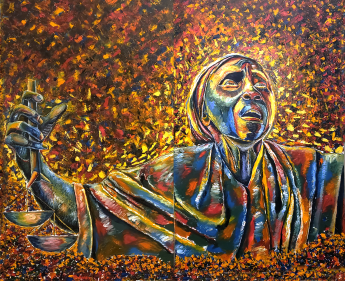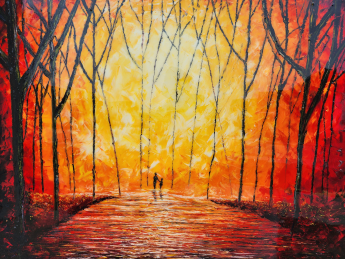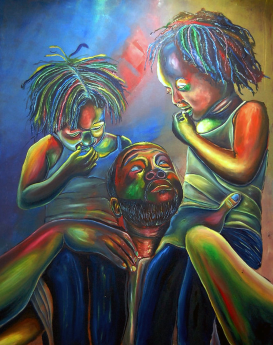Ronnie Farmer Jr. on Visual Arts and Reconciliation
Christians often wonder how to use their God-given gifts to address an issue that God cares about. Ronnie Farmer Jr., an artist and pastor, explains how the path is sometimes revealed just one step at a time. Gradually we develop our imagination to see how the Lord intends for us to use our gifts and experiences.
Ronnie Farmer Jr. is a visual artist who provides pastoral care for staff and children at I Have a Dream Preschool Academy, which he helped found. IHAD, a ministry of REAL Community Covenant Church, is the only Spanish-immersion preschool in Marion, Indiana. Farmer, an ordained pastor in the nondenominational church, is also the director of Indiana Wesleyan University’s Strengthening Ministry with Children Coordination Program. In this edited conversation, he talks about his journey into visual arts and reconciliation.
Where did your visual arts journey begin?
I grew up in a single-parent home in Augusta, Georgia. My mom really wanted me to have the opportunity to pursue my passion for drawing and painting, so I auditioned for and was accepted into sixth grade at Davidson Fine Arts Magnet School [grades 6–12]. I soon realized that I had passion for visual arts but was lacking in skill. I will never forget when my art teacher, Miss Stutts, told me, “You have something special.” Miss Stutts took me under her wing and mentored me as a young artist.
At Davidson, it was normal to see kids in leotards or holding sketchpads or violins. It was an extremely racially diverse school that allowed me to see a different world from my South Augusta neighborhood context. I became a Christian during my first year of high school and began wondering how to express my faith on canvas. I felt a call . . . but to what? Pastoral ministry? Arts ministry? It was hard to imagine a future when I hadn’t seen successful results of combining pastoral and arts ministries.
What did you do for college and graduate school?
I went to Berea College in Berea, Kentucky. Berea is a tuition-free college and one of the first in the U.S. South to intentionally educate Black and white students together. I studied art and majored in religion with an emphasis in biblical studies. Interacting with international students at Berea was a gift because it helped me more clearly see the image of God in all people and expanded my worldview.
From there I went to Asbury Theological Seminary in Wilmore, Kentucky, to earn a master’s in worship and the arts. While there I did an independent study where I interviewed individuals who had overcome addiction and destructive behaviors. Then I painted a series that chronicled personal narratives of suffering and triumph from inner brokenness. I believe that putting personal narratives into paintings can help others deal with and overcome trauma.
It sounds like seminary was a generative time for you.
Actually, my time at Asbury was incredibly difficult—such a shock after the inclusiveness at Davidson and Berea. I was I was one of maybe seven African American male students on campus and experienced both conscious and unconscious racism. I could not understand how racism could exist in such a visceral way among Christ followers at a premier theological institution.
For example, I was accused of stealing a fellow student’s chair from his room. Then, before graduation, I went to a blessing ceremony for all students preparing to transition beyond seminary. As I walked up to join a prayer circle, my accuser grabbed hands with others to leave me out of the circle. I’m not sure if it was deliberate or not. That was a genesis event for me. Outside that circle I prayed, “Lord, if you give me an opportunity to address racism and reconciliation, I will do it.”

What were the next steps in your journey of visual arts and reconciliation?
In 2010, I completed my Clinical Pastoral Education at Children's Healthcare of Atlanta, where I served as a resident chaplain in the pediatric intensive care unit. It was a very formative experience, because I learned that using creative arts, such as visual arts and music, is a great way to connect with children. I combined art, music, and live painting in hospital chapel services. I worked with families and caregivers, who were all hoping for healing and miracles. This shaped me in becoming an empathetic pastor and taught me the value of incarnational presence when people are hurting deeply.
Next I worked for TEAM Missions as a missions coach, recruiting missionaries for service in unreached countries. God gave me the opportunity to do more expansive art storytelling to inspire young people toward missional living. I worked with the development department and did live painting at fundraising events. During TEAM’s 125th anniversary, I was the featured artist during their celebration tour to major cities across North America.
What did you do after your time with TEAM Missions?
My wife, Sarah Farmer, was finishing her doctorate at Emory University and got the opportunity to work for the Adolescent Faith and Flourishing Program at the Yale Center for Faith and Culture. While we were in New Haven, Connecticut, I served as an executive pastor at Christian Tabernacle Baptist Church. I also became the first African American to serve as an artist-in-residence at Overseas Ministry Study Center. OMSC offers missionaries and other global partners unique opportunities to focus on the church’s participation in God’s mission. During my residency, I spent time doing art focused on justice, reconciliation, and family.
When Sarah was called to Indiana Wesleyan University, we did a lot of praying and discerning. It was a big adjustment for us and our three children to relocate to the cornfields of Marion, Indiana. I went on staff as the executive pastor at REAL Community Covenant Church, a multiracial and multiclass congregation.
How have you been able to work in the intersection of art, justice, and racial reconciliation in Marion, Indiana?
I and other REAL Community staff members attended a Christian Community Development Association conference in Chicago. While there, we heard Dominique Gilliard say that we have until children turn age seven to reorient the way they see their neighbors. Gilliard is director of racial righteousness and reconciliation for the Evangelical Covenant Church. He quoted research to show that children begin to form racial bias years before their parents think it’s appropriate to talk with them about race. It was a God moment.
Marion is in Grant County, which is about 88% white and has one of the highest child poverty rates of Indiana’s ninety-two counties. Research shows that learning another language helps young children develop more empathy for others. So, with help from the Evangelical Covenant Church’s Love Mercy, Do Justice initiative , our church founded I Have a Dream Preschool Academy, a Spanish-immersion preschool academy. It embodies biblical reconciliation with a diverse team so students can see adults who look like them in leadership and also develop positive images and views of themselves. All the teachers are Latina native Spanish speakers. The preschool is governed by a multiracial leadership team.
What’s one example of how IHAD promotes biblical reconciliation through visual arts?
The art and photos in IHAD normalize people of color in the public imagination, so children see the beauty of being brown and normalize the presence of leaders of color. Instead of centering whiteness, we celebrate how God has made all of us different shades of brown. Some of us have lots of brown. Others of us have only a little bit of brown. Children create papier-mâché people that duplicate their skin color. I can use my own body as a teaching resource in the classroom. I’ve had preschool boys say to me, “Hey, Pastor Ronnie, I have brown in my skin too!” Eventually we hope to find funding to expand IHAD into an elementary school.
LEARN MORE
Besides his church and job responsibilities, Ronnie Farmer Jr. sells his paintings from his website and occasionally accepts a commission to do live painting at an event. Since his time at Asbury Theological Seminary, the school has taken steps to become more diverse and more intentional about addressing racism.

